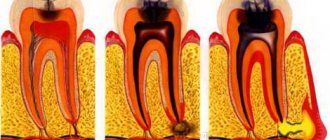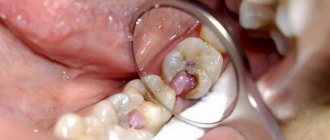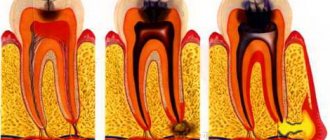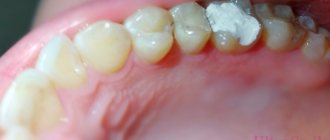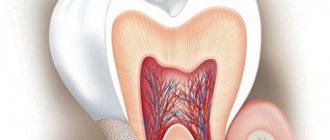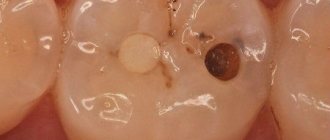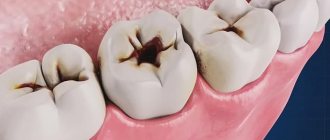The main principle of modern dentistry is the restoration and preservation of teeth, even the most problematic ones. Complex cases require more time than conventional caries filling. Such treatment usually includes several stages, and this requires the installation of a temporary filling.
At the Mitino Dental Center, appointments are conducted by experienced dentists. Our doctors successfully solve the most difficult problems, so before you decide to remove a tooth, try to save it. Make an appointment with us for a consultation and initial examination.
What is a temporary filling and what types does it come in?
This method of treatment is used for deep caries, pulpitis, and also for inflammatory processes in the root canals. A temporary filling means closing a tooth canal with a special compound that provides tightness and protection only for a certain time. This filling can be easily removed to continue the necessary treatment. That is why she is not able to withstand chewing loads for a long time. After completion of treatment, permanent filling must be carried out.
Such fillings have a safe and plastic composition that is easily distributed throughout the tooth cavity and dries quickly. Modern temporary filling material can be of the following types:
- artificial dentin - powder made from kaolin and zinc sulfate, which is diluted with plain water;
- cements – polymer, glass ionomer and zinc phosphate;
- dentin paste is an oil-based composition that contains zinc sulfate cement;
- Vinoxol is a zinc sulfate cement that has good strength;
- Karyosan - available in powder and liquid form.
These compounds have less protection from external influences than filling materials for permanent fillings. The type of paste is selected only by the doctor, based on the purpose and duration of treatment. Some formulations are designed for up to 1 week, while others last for several months.
Features of light seals
Light filling is considered a more modern tool for caries treatment. The exposure time to ultraviolet rays of a special lamp, which is used to harden light fillings, is no more than 30-40 seconds; If exposure to the UV lamp is prolonged, the filling will develop cracks, which can damage the surrounding healthy tooth enamel or even destroy the tooth being filled.
In order to minimize possible harm to healthy tooth enamel, the filling composition of the light filling is applied in layers, each applied layer of filling is cured individually, layer by layer. Layer-by-layer curing of fillings also helps give the tooth the most natural appearance. It is also important that as a result of the layer-by-layer application of the component of the light-hardening filling, the dentist has the opportunity to most accurately adjust it to the desired shape. The light seal is easily selected by shade and is invisible to prying eyes. For anterior teeth, due to the presence of composites made of microparticles, light fillings differ from chemical fillings in their high aesthetic qualities. For molars, light fillings are made from composites with larger particles designed to withstand high chewing loads for greater resistance to abrasion.
Why are conventional fillings still used?
It would seem obvious that a light-curing filling is superior to chemical fillings in all cases - in terms of speed of installation and visibility. But, despite this, there are factors when the usual chemical filling, for some reasons, cannot be replaced with a light one: a light-curing filling cannot always be used to treat severely advanced cases of caries, when treatment of deeply affected areas of the tooth is required.
Light fillings are more suitable for surface application, and the price of a light filling is several times higher than the usual one, therefore, when filling back teeth, it is always more profitable for the patient to use conventional chemical fillings. In addition, one should not discount the fact that conventional fillings are more resistant to physical impact, for example, abrasion during chewing, so it is better to fill the chewing surfaces of molars with conventional chemical fillings, and light ones to be placed on the front teeth and the smile line.
Indications for the use of light fillings:
- carious tooth decay;
- dental injuries with chipping;
- correction of damaged teeth if the crown part is preserved more than 50%;
- small and medium enamel defects, light-curing fillings allow you to create small patches for small areas of enamel where chemical fillings will not hold.
Disadvantages of light fillings:
- Possible insufficient polymerization, approximately 60-70%, this factor can have a negative impact on the shade of the filling;
- shrinkage of the filling (when exposed to light, the composite of the light seal may shrink, as a result of which the light seal has a risk of peeling off).
The most famous and frequently used manufacturers of light-curing compounds
Degussa (Germany); Noritake (Japan); Dipol (USA); GC America (USA); Fuji (Japan); Bisco (USA); Kerr (USA).
Why do they put a temporary filling?
In cases where there is a pathological process in the root canals, preliminary treatment with various medicinal compounds is required. In order for the medicine to remain in the canal for the required period, it is secured by installing a temporary filling. It also acts as a protective barrier against germs, bacteria and food debris that can get into the cavity of a diseased tooth.
Main indications for temporary tooth closure:
- Isolation of therapeutic antiseptic pad.
- Inflammation of the pulp (pulpitis). For this, arsenic paste is used to destroy the nerve of the tooth.
- Deep caries with damage to dentin.
- Periodontitis.
- Manufacturing of ceramic permanent inlay.
- The need to reschedule treatment.
Sometimes temporary filling is used for diagnostic purposes. If caries has damaged the deep layers, then it is impossible to find out exactly how damaged the pulp is. Therefore, the doctor must observe the tooth to choose the optimal treatment. The absence of pain indicates the vitality of the tooth, which means there is no need to remove the nerve.
Dental cements
Cement is a cheap material that has been used in dental practice for many years. Before the development of modern composites, 5 types of dental cements were used, three of them have serious disadvantages:
- Silicate ones are fragile, crumble quickly, and quite toxic.
- Zinc phosphate - shrink, so they are used only for gaskets.
- Silico-phosphate - do not adhere well to the edges of the formed cavity and wear out quickly.
Polycarboxylate cements contain fluoride, which strengthens teeth. Such cements are more reliable, but also crumble. Due to their low wear resistance, polycarboxylate cements are recommended for filling baby teeth.
Glass ionomer cements are the most durable and contain fluorine-aluminum silicate glass and polyacrylic acid. Used in the treatment of pulpitis and periodontitis as an intermediate filling. It closes the tooth cavity while there is a medicine inside that “kills” the nerve.
Installing a temporary filling
The decision to perform a temporary tooth filling is made by the dentist after a preliminary examination. X-ray diagnostics are also performed. The main rule is that in case of a purulent lesion, the tooth cavity should remain open. Only after complete elimination of the purulent contents, the tooth is temporarily closed with the installation of a therapeutic lining.
Installation takes no more than 30 minutes. The doctor performs the following manipulations:
- cleaning the canal with an antiseptic solution;
- laying down the medicinal composition (if necessary);
- installation of temporary filling material.
Since the temporary filling takes more time to completely harden, it is not recommended to eat for 2 hours after the procedure. Solid foods should be excluded from the menu for a day.
Important! A temporary filling may break due to exposure to saliva. Therefore, it is important to carefully monitor oral hygiene during the treatment period. Be sure to use antiseptic rinsing solutions.
If pain occurs, consult a doctor immediately!
Indications for filling
- Impaired functionality and shape of teeth.
- Invasive intervention in tooth tissue, dental canals.
- Elimination of aesthetic defects - chips, abrasion of enamel.
- Temporary sealing of medicinal or devitalizing drugs in the tooth cavity.
Our doctors
Kuzovleva Natalya Vladimirovna more than 15 years of experience Sign up
Radabova Nadezhda Bogdanovna experience more than 20 yearsSign up
Silkina Milana Vladimirovna experience more than 10 years Sign up
Dzhevelekis Sergey Yanisovich experience more than 10 yearsSign up
How long does a temporary filling last?
The period depends on the diagnosis and the purpose of the temporary filling. This could be a few days or several months. Approximate terms for which the seal is placed:
- Nerve killing for pulpitis and deep caries - from 1 day to a week. This depends on the composition of the filling material.
- It takes 1–3 weeks to eliminate the inflammatory process in the tooth canal.
- When treating cysts, a temporary filling can last up to 2-3 months.
The decision is made only by the attending physician. But on average, a permanent filling is placed no later than after 10–14 days.
Important! You cannot wear a temporary filling for longer than the period prescribed by your dentist. This can lead to relapse of the pathological process.
Advantages of filling at OneDent
- Specialists with more than 10 years of experience.
- High level of aesthetics: fillings installed in our clinic do not stand out in the dentition.
- Durable materials: restorations last more than 7 years (with proper care).
- Perfect fit and minimal shrinkage - no caries forms at the interface between the material and dental tissues.
- Affordable cost of services, options for any budget.
Installation example "Before and After"
Features of care after temporary filling
Since temporary filling material is less durable than material for permanent fillings, excessive chewing and thermal stress can lead to its destruction. Therefore it is recommended:
- use a soft toothbrush;
- exclude the use of pastes with aggressive bleaching or polishing compounds;
- after eating, rinse your mouth with antibacterial rinses that were recommended by your doctor;
- exclude chewing gum and other viscous products.
Also prohibited are seeds, chips, and nuts.
Composite materials
Composites can be chemo-cured or light-cured:
- Chemically cured ones are similar in composition and characteristics to plastic mass. They have been used since the mid-70s and are considered obsolete.
- Light-curing (photopolymer). The basis of the composition is composite resins mixed with ceramic or silicon particles. The composite material is applied in layers, each time irradiated with ultraviolet light. When exposed to UV rays, the composition quickly hardens. Patients call this type of filling light.
Advantages of light-curing composites:
- wear resistance;
- biocompatibility with natural tissues;
- a large selection of shades close to the natural color of the enamel;
- efficiency of installation.
Composite fillings can be polished twice a year. The disadvantage of light filling is slight shrinkage.
Possible complications
Common problems that may arise after installing a temporary filling include:
- Discomfort or soreness. On the first day, a little pain is normal. But if the pain intensifies, and even more so, soft tissue swelling appears, then consult a doctor earlier than scheduled. This symptom may indicate a possible infection, as well as the spread of the pathological process.
- Strange taste in mouth. May occur if a medicated pad is used. But if the taste is strong and unpleasant, then this means that the seal’s tightness is broken. Reinstallation required.
- Change in enamel color (darkening) or redness of the gums around the tooth. Alarm signal. A medical examination and x-ray are required.
The appearance of any severe discomfort should alert you. If you do not see a doctor on time, you can get complications, including tooth loss.
What to do if the filling falls out
Even if you follow all the dentist's recommendations, the filling may fall out. This mainly happens for two reasons:
- Low quality of the filling material used.
- Doctor's error during installation.
But in most cases, the filling falls out due to the fault of the patient himself. In any case, if a temporary filling falls out, you should definitely contact the doctor who installed it. Walking around with an open cavity in a tooth can cause it to become infected. It is also prohibited to cover it with cotton wool, chewing gum or other improvised materials.
Preparation for the procedure
Dental care begins to be provided at the initial doctor’s appointment. The dentist conducts a standard examination of the oral cavity, identifies defects in hard tissues, inflammatory processes, determines the area of medical intervention, and prescribes x-ray diagnostics. An orthopantomogram helps to detect hidden carious lesions of dental tissues, determine their stage and shape (approximal, complex cervical caries).
The Dento-comfort clinic is equipped with digital X-ray equipment. Orthopantomography differs from conventional x-rays in a reduced dose of radiation exposure and a shorter examination period. The device rotates around the patient's head, the received data is converted by a computer program into an image on the monitor. Diagnostics takes 30 seconds.
The second stage is drawing up a treatment plan. Dento-comfort doctors develop a therapeutic regimen based on dental characteristics, indications, contraindications, and premorbid background. Our doctors are attentive to the patient’s wishes and follow the approved treatment protocol.
According to the treatment plan, the cost of installing a filling on the tooth is calculated. Taken into account:
- material price;
- doctor's workload;
- applied methods;
- endodontic equipment;
- additional costs for anesthetic, dental microscopy.
The financial plan specifies prices for each stage (preparation, filling).
